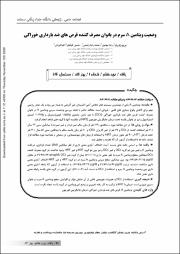| dc.contributor.author | Rafraf, maryam | en_US |
| dc.contributor.author | Mahdavi, reza | en_US |
| dc.contributor.author | Rashidi, mohammad reza | en_US |
| dc.contributor.author | Koshavar, hosein | en_US |
| dc.contributor.author | Farzadi, laya | en_US |
| dc.date.accessioned | 1399-08-21T21:42:12Z | fa_IR |
| dc.date.accessioned | 2020-11-11T21:42:12Z | |
| dc.date.available | 1399-08-21T21:42:12Z | fa_IR |
| dc.date.available | 2020-11-11T21:42:12Z | |
| dc.date.issued | 2006-01-01 | en_US |
| dc.date.issued | 1384-10-11 | fa_IR |
| dc.identifier.citation | Rafraf, maryam, Mahdavi, reza, Rashidi, mohammad reza, Koshavar, hosein, Farzadi, laya. (2006). Serum vitamin A status in women users of lowdose oral contraceptives and in postmenopausal women taking hormone replacement therapy.. scientific magazine yafte, 7(1), 61-68. | en_US |
| dc.identifier.issn | 1563-0773 | |
| dc.identifier.uri | http://yafte.lums.ac.ir/article-1-1071-en.html | |
| dc.identifier.uri | https://iranjournals.nlai.ir/handle/123456789/483146 | |
| dc.description.abstract | Background: One of the most important nonenzymatic antioxidant defense systems
is vitamin A, and is considered as an important dietary agent for reducing
cardiovascular diseases.
Objective: The objective of this study was to investigate the serum vitamin A status
in women who used low-dose oral contraceptives (OCs) containing 0.15 mg
levonorgestrol and 0.03 mg ethinyl estradiol and also in postmenopausal women who
took hormone replacement therapy (HRT) and comparison of them with control
group.
Materials and Methods: In this case – control study one hundred and thirty nine
healthy, non pregnant and non lactating women with a mean age of 32 years old (70
were OCs users and 69 were non-OCs Users) and sixty healthy postmenopausal
women, with a mean age of 51 years old (30 were under HRT treatment and 30 were
untreated) were studied using biochemical procedures, anthropometrics measurements
and interview with the subjects. Data were analyzed using the t-test and x2 test.
Findings: There was no significant difference between either OCs and non-OCs
users or HRT and non-HRT groups in terms of mean BMI, number of pregnancies and
dietary intakes of vitamin A and fiber. Mean serum vitamin A level in OCs Users was
significantly (p<0. 001) higher than that of non – OCs users (79.97±23.56 μg/dl vs.
64.56±22.15 μg/dl). There was no significant difference between HRT and non-HRT
groups in terms of mean serum vitamin A level (71.76±15.91 μg/dl and 67.65±22.39
μg/dl respectively). There was a significant (P<0.004) relationship between serum
Vitamin A status and use of OCs analyzed using x2 test. This test did not show
significant relationship in postmenopausal women.
Conclusions: Using OCs and subsequent hormonal alteration are an effective factor
for increasing serum vitamin A level in childbearing aged women. Taking HRT has
not resulted in altered vitamin A levels in postmenopausal women. | en_US |
| dc.format.extent | 232 | |
| dc.format.mimetype | application/pdf | |
| dc.language | English | |
| dc.language.iso | en_US | |
| dc.relation.ispartof | scientific magazine yafte | en_US |
| dc.relation.ispartof | مجله علمی پژوهشی یافته | fa_IR |
| dc.subject | Vitamin A | en_US |
| dc.subject | Oral contraceptives | en_US |
| dc.subject | Hormone replacement therapy. | en_US |
| dc.title | Serum vitamin A status in women users of lowdose oral contraceptives and in postmenopausal women taking hormone replacement therapy. | en_US |
| dc.type | Text | en_US |
| dc.type | Research | en_US |
| dc.citation.volume | 7 | |
| dc.citation.issue | 1 | |
| dc.citation.spage | 61 | |
| dc.citation.epage | 68 | |





